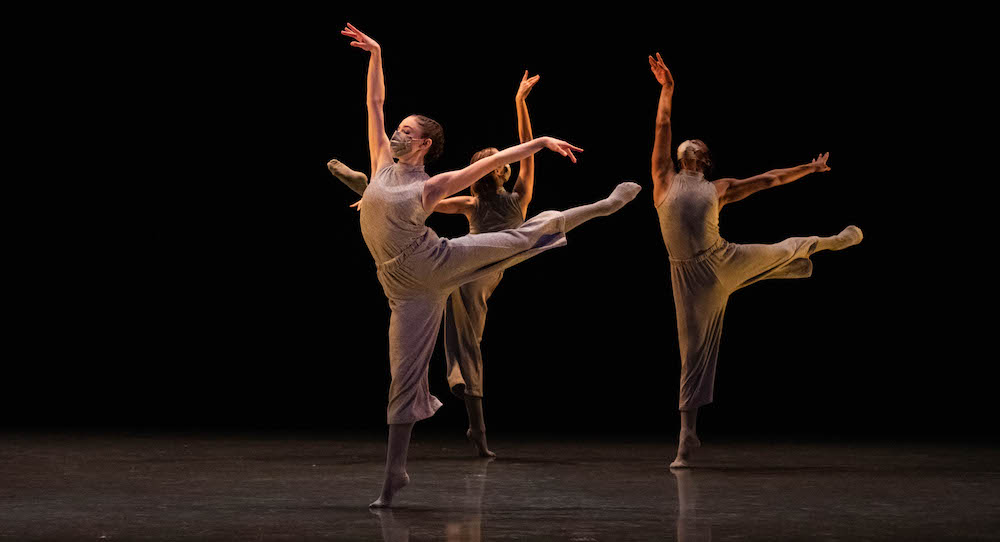Available through www.bostonballet.org.
May 12-26, 2021.
The 2020-21 season has been anything but easy for dance companies. Yet, in their own ways, they’ve found innovative ways to keep the mission alive and still keep all involved safe: livestreamed and video performances, outdoor and virtual community events, and other ways to safely connect with audiences and communities. Boston Ballet has presented its inaugural digital season, with both new and archival works — some honoring choreographers (such as William Forsythe and Jorma Elo), celebrating the holidays, and revisiting iconic programs that the company has presented. Process and Progress topped off the season, presenting a variety of compelling concepts and memorable aesthetics, thus reflecting the multiplicity and dynamism of the overall season.
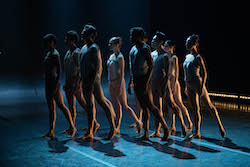
Ken Ossola’s Zoom In opens the program, a work that’s memorable on multiple levels — movement, meaning, and overall aesthetic effect. It begins with lights slowly coming up on a dancer in the foreground, lit from behind, wiggling in an improvisationally serpentine way. Meanwhile, dancers in the background slowly shift from shape to shape. That moves into a pas de deux and a solo, shifting tempo to something slower and more contemplative.
In the following section, each dancer comes to and away from the camera. Then dancers move together in a line, in unison. A following solo has another dancer simply observing the soloist move. All of these choices, and the dynamics they create, bring to mind the individual within the group — “zoom[ing] in” on different individuals in turn. At times, as feels inevitable within human experience, individual experience and action is in tension with that of the group.
Throughout these and various other groupings, abstraction and curvilinear qualities characterize the movement — which also aligns with the expressiveness and dynamism of the music. The choreography also underscores classical line and length, yet also has no fear of releasing energy downward and moving the spine and limbs in ways not commonly seen — exploring and arriving at ingenuity of shape. Through all of this captivating movement, lighting (by Brandon Stirling Baker) and the dynamic instrumental score (“Fratres” by Arvo Pärt) adds aesthetic layers onto it. These elements also add various other potential interpretations for different viewers to find in the work.
As another reference to the title, the camera zooms in on particular body parts — a hand to a knee, a chest leading a spinal twist or undulation. The work seems to center a certain aesthetic effect, through a constellation of sensory inputs. Yet, the ways in which dancers interact and don’t interact, follow and lead, conform to the group and separate from it all speak to social dynamics and truths within human interactions.
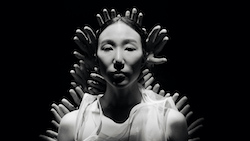
Nanine Linning’s La Voix Humaine feels like a surrealistic film noire dance for the twenty-first century — speaking to contemporary issues and experiences. It begins with a woman (Ji Young Chae) — the work’s protagonist — dropping a phone from lying down, leaving it off the hook. She rises and turns away, and then dances alone. Her body and soul are seemingly fully absorbed in movement and feeling. She gestures abstractly but also turns and extends — reaching out parts of herself for connection and attempting to find new vantage points. Accompanying her throughout is an instrumental score with a woman singing in French (“La Voix Humaine” by Francis Poulenc), contributing to the mystery and theatricality.
Meeting the abstraction in her movement, abstract images emerge from time to time: a wall that looks like a gigantic cobweb, chocolate pouring over her head, fingers behind her head closing in (film editing by Ernesto Galan). Chillingly strange beings dressed fully in gray, including their faces, dance with her at one point (costume design by Shane Maxwell and Erica Desautels). There’s something eerie about anything faceless; perhaps we look to facial expression for understanding, and therefore a feeling of safety from increased certainty.
In a sort of inverse of those beings, creatures dressed all in white with faces on front and back come to surround her — speaking to extremes and uncertainty within them. The black and white coloring through it all connects with that surrealism, building a Hitchkockian film noir feel and supporting the overall tone at hand.
Soon, even though alone, she turns and extends limbs frantically, as if having to fend off nefarious beings. Throughout the work, but particularly in this section, Chae shows both breathtaking technical facility and theatrical chops to pull me right into her emotional world. In that Hitchcockian-sense, it feels hard to know what’s reality and what’s the protagonist’s experience alone. Perhaps that’s the exciting part!
If there are delusions at hand, perhaps brought on by trauma or even the emotional weight of isolation, the work does not comment or condemn — it only illustrates. To end, strands that seem like long locks of hair slowly wrap around the protagonist. Has her inner turmoil overcome her? We can’t know, we can only question and conjecture for ourselves. Again, maybe that’s the exciting part!
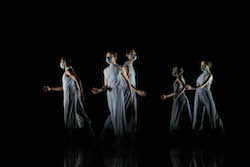
Lex Ishimoto’s What Happens If… exudes a modernist sense of suave, something cohesive built through experimentation and exploration. Dancers in unassuming, loose-fitting grey costumes move amidst purple lighting and against a black backdrop (lighting design by Jon Gonda). Their movement of dynamically shifting shapes moves with the beats, trills, and clicks of the electronica music (by Kurtis Sprung). The aesthetic at first seems simple, yet also has pleasing layers to peel back.
With a jazz saxophone coming in, something smoother emerges, if at times still with accented counts. The movement somehow smoothly blends contemporary styling — released movement on the floor and parallel, flexed-feet attitude shapes — with arabesques and petit allegro; one might think this would be discordant, but it’s somehow just exploratory and boundary-pushing — as well as quite aesthetically satisfying. It feels like the product of an open, harmonious creative environment and overall process.
In a true abstract sense, the dancers don’t interact as individuals or build overtly unique personalities through theatricality. Yet towards the end one dancer, Lia Cirio, breaks from the group, looking out and down — as if apprehensive or uncertain. She then looks back toward the group and reaches toward them, not only with her arms but with the energy of her whole body. Feeling like things just go on alright while we lack connection, while also desperately craving that connection, is something that many can identify with nowadays.
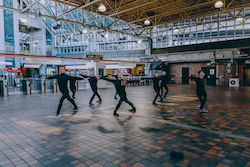
John Lam‘s moving pARTS is an intriguing exploration of the movement of transportation, inflected with the weight of the COVID-19 global trauma. Daniela Goncalves wrote and directed the work while Daniel Latimer contributed film editing. In subway stations and subway cars, dancers embody the directional energies of city transit through moving in angular, direct ways. Occasional curves and gestures do reflect the curveballs that transit issues can throw in our days — something that urban commuters know well! Intentional gaze and touch underscore the humanity at hand, a reminder that real humans underlie it all.
Black costumes and a somber, resonant score (based on the Catalan folk song “El cant dels ocells” with cello and composition from Ronald Lowry) — and of course, the dancers’ masks — don’t let the reality of COVID stray too far from viewers’ minds. The score only comes in when the dancers begin to move together, when before and after that dancers were traveling on their own ways in separate subway cars — and the typical announcer and rumbling track sounds of the subway were the only score to be heard (soundscapes, editing and mastering by Mischa Santora). In a heartwarming way, everyday people look to the dancing with curiosity. Those who know Boston will also recognize the stations and the cars — I myself, having lived there for almost seven years, feel a pang of nostalgia from these scenes.
Just as the characters in the film find connection through the art of dance, a film like this can connect us with parts of our pasts as well as with each other through common experience. COVID can certainly be a big damper on such connection, but it has never had to completely stop us. Thank you to Boston Ballet for being part of that connection with this program and all programs in your first ever virtual season — brava and congratulations!
By Kathryn Boland of Dance Informa.


